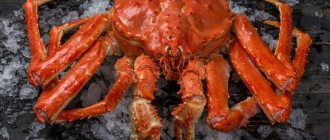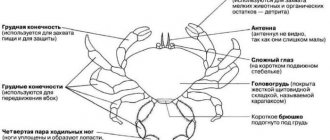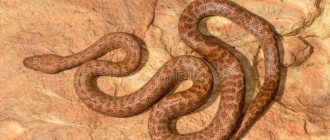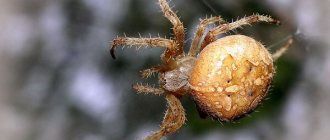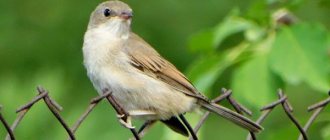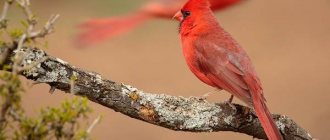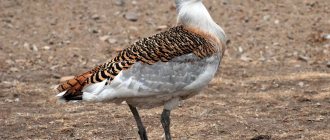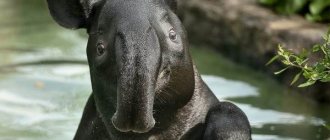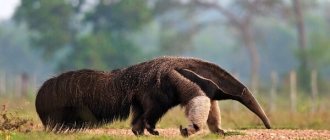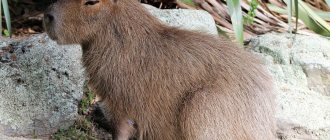Crabs belong to the infraorder of decapod crustaceans. They have a small head and a short abdomen. They can be found both in fresh water bodies and in the seas. There are 6,780 species of crabs, all of different sizes and colors.
The smallest is the pea crab, the size of which does not exceed 2 mm. The largest crabs weigh 20 kg. Each has 10 legs and 2 claws. If he loses a claw, he can grow a new one, but it will be smaller in size.
They are omnivores, eating algae, mushrooms, crustaceans, worms, and mollusks. Crabs move sideways. For more information about the largest short-tailed crayfish, as crabs are also called, read our article.
Maltese freshwater crab, 150 g
As is already clear from the name, this crab prefers freshwater bodies of water, namely streams, rivers and lakes, lives in burrows, young individuals hide under stones. Their burrows are quite long, reaching up to 80 cm in length. They are his refuge not only from predators, but also from the cold.
Found in Southern Europe. An adult grows up to 5 cm in length, females are smaller than males. The Maltese freshwater crab lives from 10 to 12 years. He is omnivorous, can eat plants, frogs, and tadpoles, and will not refuse snails and worms.
Quite aggressive. There are no predators that feed only on this type of crab, but birds, foxes, rats, and ferrets can prey on them. However, the most dangerous enemy for them is man.
Maltese crab has been eaten since ancient times. One catcher can collect from 3 to 10 thousand crabs per season. They are under threat due to overfishing.
Use in cooking
If you are lucky enough to buy an edible specimen, you can surprise your relatives and test your culinary talents. They can be prepared either whole or separately in parts. In terms of taste, different types of inhabitants are slightly identical, but also different:
- sweetish;
- salty;
- fleshy;
- dry;
- distinguishable fibers, etc.
It can be baked, fried, boiled, prepared first courses, salads, pasta, cutlets, sushi, hot dogs and much more. If you use sauces, then the following are suitable:
- Tartarus;
- aioli;
- wasabi;
- sriracha, etc.
Fans prefer to cook the inhabitants whole in order to feel the aroma of the juice that appears inside the shell. From alcoholic drinks, wines, especially white ones, are suitable for the product.
Nutritionists recommend eating arthropods, as they are characterized by excellent taste, and are rich in vitamins, macroelements, and other important substances. The composition contains zinc, selenium, potassium, iodine, phosphorus, omega-3 polyunsaturated fatty acids, protein, calcium, vitamins A, PP and group B.
It should be eaten to normalize the condition of the heart and blood capillaries, prevent associated pathologies, lower cholesterol levels in the bloodstream, improve vision, and also cope with thyroid pathologies.
Blue crab, 900 g
Their homeland is North and South America. The blue crab chooses to live in shallow waters and river mouths. Selects sandy or muddy bottom. He needs warmth. He, like all crabs, is omnivorous. If there is not enough food, it can eat its own kind. Its width is from 18 to 20 cm, and its length is from 7.5 to 10 cm, males are slightly larger than females.
The blue crab received this name because of the color of its shell, which can be not only brown and gray, but also greenish with a blue tint.
He lives from two to four years. He spends most of his life hiding. It is preyed on by sea turtles, herring gulls and other animals. People also catch it, because... it is considered a delicacy.
Spiny crab, 2 kg
It can be found in the northeast of the Pacific Ocean, in the Bering and Okhotsk Seas, in Kamchatka, near the Kuril Islands and near Sakhalin.
The width of its carapace is from 11 to 14 cm, females are slightly smaller - from 10 to 13 cm. It is covered with large and thick spines. Weighs from 800 g to 2 kg. The comfortable depth for them is 25 m, but in southern waters they go lower and can be found at a depth of up to 350 m.
When the water temperature drops, it can swim to river mouths, where it is not so cold. He was able to adapt to fresh water. Spiny crab is red or burgundy in color. Its meat is a real delicacy; it is sweetish, juicy, and filling.
Snow crab opilio, 2 kg
Its other name is common snow crab , it lives off the coast of the Bering and Okhotsk Seas, and is also found in Canada, off the coast of Greenland, etc. It can be at a depth of 13 to 2 thousand meters.
The width of the crab is 16 cm, the leg span is up to 90 cm. Females are 2 times smaller than males. Their shell is reddish in color, covered in tubercles and spines. The snow crab opilio feeds on bottom-dwelling invertebrates. There may also be carrion. They have sweetish meat, which is high in protein and low in fat.
Coconut crab, 4 kg
Despite the name, it is not a crab, but a type of decapod. It is also called the palm thief . They call him that because they used to believe that he could climb palm trees and cut coconuts from them, so that he could then eat the pulp of the broken nut. Moreover, if the coconut is not cracked, it easily opens it with its claws.
But biologists say that the coconut crab does not know how to get nuts, but does not mind feasting on “fallen animals” that were torn off by the wind.
The palm thief grows up to 40 cm. It has really strong claws with which it can crush small bones. It feeds on coconuts, pandan fruits, and other crustaceans. Lives in shallow burrows, which are lined with coconut fibers, sometimes hiding in rock crevices. Can climb a tree.
Appearance
Since the hermit crab spends its entire life in its shell, it is difficult to say exactly what its appearance is. It is known that the outer part of the body, which usually looks out of the shell, is covered with a thicker chitinous layer. The hidden part is covered with a relatively soft cuticle, since it does not have a protective chitinous layer. The shell is held on the body by small legs.
Blue crab, 4 kg
This is also a craboid, i.e. looks like a crab, but belongs to hermit crabs. Externally similar to Kamchatka crab. Its width is up to twenty-two centimeters in males, and slightly less in females. Weight – up to five kilograms.
The body is red with a brown tint, tinged with blue, and the underside is yellowish-white, with orange spots. It is covered with spines; young crabs have tubercles instead of spines.
They live quite a long time, from 22 to 25 years. This species can be found in the Seas of Japan, Bering, and Okhotsk. Blue crab is eaten.
Nutritional Features
The main diet of the Kamchatka crab is urchins, mollusks, worms, stars, various types of fish, plankton, as well as various types of crustaceans. It should be noted that such an arthropod is an omnivorous predatory inhabitant. Young Kamchatka crabs prefer to feed on hydroids. The claw on the right side of the animal is designed to destroy the hard shell, and using the left claw, the crab eats the soft and tender internal components.
Large land crab, 3 kg
Other names are brown or edible crab , because. it is reddish-brown in color. It is shaped like a closed pie. The width of the shell of an adult individual can reach 25 cm, but, as a rule, 15 cm, and it weighs up to 3 kg. The length is most often about 6 cm in males, almost 10 cm in females, and up to 15 cm in some individuals.
He lives in the North Sea, in the Atlantic Ocean. Prefers to hide in cracks and holes in rocks and is nocturnal. The large land crab feeds on crustaceans and mollusks, stalks prey or lures it into ambush.
His main enemies are octopuses, as well as people. They are caught in large quantities; in 2007, 60 thousand tons were caught around the British Isles, which is why this type of crab has almost disappeared there.
Reproduction
Males reach sexual maturity at 10 years, females at 7-8. The appearance of offspring is associated with the molting process. In due time, eggs form on the females’ legs, close to the abdomen. Having migrated to shallow water in separate groups, females and males meet and take a joint pose, reminiscent of a handshake - he holds her with his claws and does not let go until the female has finished molting. Thus, the male can protect his girlfriend during the period when she has a soft shell.
This lasts approximately three days, a maximum of a week. When the female's molt is completed, the male throws out a ribbon with spermatophores, which wraps around the female's legs. The male releases the female and goes to a secluded place to molt himself. Over the course of a season, he can enter into relationships with several representatives of the opposite sex.
The female, after a few hours (sometimes it takes several days), spawns eggs. There are many eggs, tens or even hundreds of thousands. They meet the ribbon, fertilization occurs. After this, the eggs attach to the mother's legs. This happens easily, since the caviar is sticky in texture, and the abdominal legs of the female have villi that hold it.
The development cycle of a new crab takes almost a year, until next spring. When the next spring migration begins, the larvae hatch from the eggs and set off for free swimming. At the same time, new eggs are formed in the female’s body to begin the next cycle. The fate of the larvae is very dramatic - driven by the current, they float around in sea water for a couple of months, while only about 4-10% of the total mass survives. These larvae, having passed the sieve of strict evolutionary selection, find a mud bottom, end up in algae thickets and live there in relative safety for three years. During this period they molt several times.
Having matured a little, the young move to the sandy bottom. Having reached five years (maximum - seven), young king crabs begin to migrate in separate junior groups.
Tasmanian king crab, 6.5 kg
The Tasmanian king crab , or, as it is also called, the giant Tasmanian crab , is one of the largest in the world, its width is up to 46 cm, and its weight can reach up to 13 kg. The males are especially noticeable in size, being 2 times larger than the females. It is light in color with red spots.
This type of crab can be found in southern Australia, at depths from 20 to 820 m, but it prefers depths from 140 to 270 m. It feeds on mollusks, starfish and crustaceans.
They are being hunted because... These crabs have a lot of meat and it tastes good. One of the representatives of this species was caught off the coast of Australia, which was named Claude. He was bought by the British Aquarium for 3 thousand pounds sterling. Despite the fact that he was quite young, he then weighed about 7 kg, but, according to experts, as he matures, Claude can become 2 times heavier.
What does it eat?
The Kamchatka crab is an omnivore; it prefers to eat a variety of mollusks, plankton, worms, sea urchins, crustaceans, ascidians, small fish, and starfish. Young individuals eat algae and hydroid organisms, worms. The food goal forces animals to make mass movements. With the help of powerful claws, the crustacean kills its prey. In cases of lack of live food, it feeds on carcass remains from fish and various organisms. The animal has a unique feature of adapting to different foods. So, while waiting to molt, the crab looks for food containing a high level of calcium.
Its frame is highly durable and provides a high level of protection, but does not allow the body to grow between shell changes. Therefore, the crab can only grow in a short period of time, which lasts up to 72 hours. At this time, the animal sheds the old frame, and the new one is easily stretchable and does not prevent the crab from growing. After this, the chitin cover gradually strengthens and stiffens due to calcium salts. Then the growth of the Kamchatka crab stops.
Kamchatka crab, 8 kg
Kamchatka crab is also a craboid, i.e. looks very similar to a crab, but belongs to hermit crabs. This is the largest crustacean living in the Far East. It is red-brown, yellowish below, and has purple spots on the sides. It grows up to 29 cm in width, plus limbs that reach 1-1.5 m.
For life, he chooses an area with a sandy bottom, depth from 2 to 270 m. He likes to live in cool water of medium salinity. He prefers to lead an active lifestyle, constantly moving.
They tried to breed Kamchatka crab in the Barents Sea, after several unsuccessful attempts everything was successful, it began to reproduce successfully there. The Kamchatka crab feeds on sea urchins, crustaceans, mollusks, small fish, and starfish.
Life and Molting
When a king crab transforms from a larva into an adult, its skeleton skeleton changes several times. This type of molting occurs frequently at first, and becomes less common as they grow older. The new shell grows under the old one, and when it is shed, it begins to grow stronger, absorbing calcium salts from the water until it reaches the desired state. The chitinous walls of internal organs also change. The color of the mature shell is red-brown, with purple spots on the sides. The abdomen is distinguished by a white and yellowish tint.
When molting occurs, the Kamchatka crab spends time in shelter until the new frame gets stronger. This period is favorable for the growth of the animal. When the shell is hard, the arthropod cannot change in size, and only when it is still soft is this possible. The result is impressive growth.
The animal moves on four pairs of legs with good speed, sideways. The average lifespan of an individual is 20 years.
Japanese spider crab, 20 kg
The span of one pair of legs is up to three meters. It can be found in the Pacific Ocean, near Japan, at a depth of 50 to 300 m. Its body length is up to 80 cm, and with its legs up to 6 m, it weighs from 16 to 20 kg.
It's not so easy to catch him, because... with its claws it can seriously injure. Japanese crab is a delicacy. Once upon a time, 27-30 tons were caught per year, but now the fishery has been reduced to 10 tons, during the breeding season of crabs, i.e. in the spring, you can’t touch them.
They themselves feed on both plant and animal food, and do not refuse carrion. Their natural enemies are octopuses and squids.
22 3
Links[edit]
- Richard G. Hartnoll (1988). "Biology of Land Crabs: An Introduction". In Warren W. Burggren and Brian Robert McMahon (eds.). Evolution, systematics and geographical distribution
. Cambridge University Press. pp. 6–54. ISBN 978-0-521-30690-4. - ^ abc Warren W. Burggren and Brian Robert McMahon (1988). "Biology of Land Crabs: An Introduction". In Warren W. Burggren and Brian Robert McMahon (eds.). Biology of Land Crabs
. Cambridge University Press. pp. 1–5. ISBN 978-0-521-30690-4. - ^ ab Colin Little (1990). "Life on Land". Terrestrial Invasion: An Ecophysiological Approach to the Origin of Land Animals
. Cambridge Studies in Ecology. Cambridge University Press. pp. 201–275. ISBN 978-0-521-33669-7. - Ben Hoare (2009). "Red Crab" Animal Migration: Remarkable Journeys in the Wild
. University of California Press. pp. 74–75. ISBN 978-0-520-25823-5. - Burggren, W. W.; McMahon, B. R., ed. (1988). Biology of Land Crabs. Cambridge University Press. pp. 53–54. ISBN 978-0521306904.
- Tan, C.G.S.; Ng, P. K. L. (1995). « Geosesarma notophorum
sp.
Nov. (Decapoda, Brachyura, Grapsidae, Sesarminae), a land crab from Sumatra, with novel brooding behavior.” Crustaceans
.
68
(3):390–395. DOI: 10.1163/156854095X00557. - Huang, Chao; Wong, Kai Chin; Ahen, Shane T. (December 20, 2022). "Freshwater crabs of Macau, with a description of a new species Nanhaipotamon Bott, 1968 and a redescription of Nanhaipotamon wupingense Cheng, Yang, Zhong & Li, 2003 (Crustacea, Decapoda, Potamidae)". ZooKeys
(810): 91–111. DOI: 10.3897/zokeys.810.30726. ISSN 1313-2970. PMC 6308228. PMID 30613174. - ZooBank.org. zoobank.org
. Retrieved June 20, 2022. - Michael Dobson (2004). "Freshwater Crabs in Africa" (PDF). Freshwater Forum
.
21
: 3–26.
